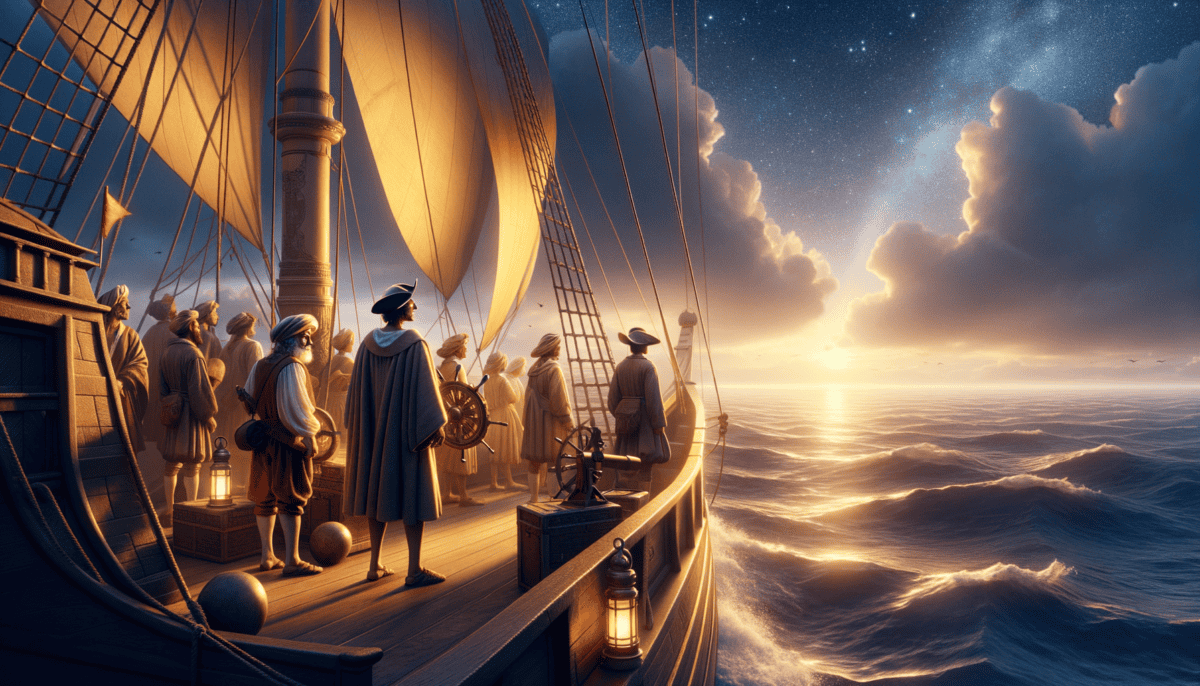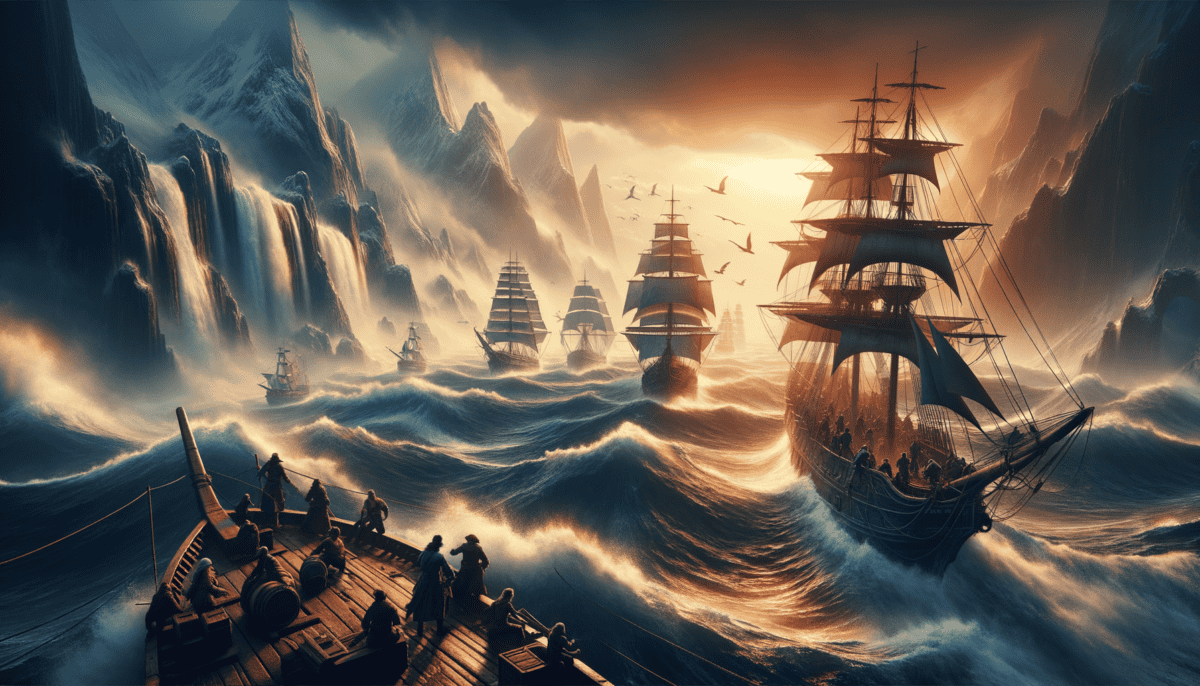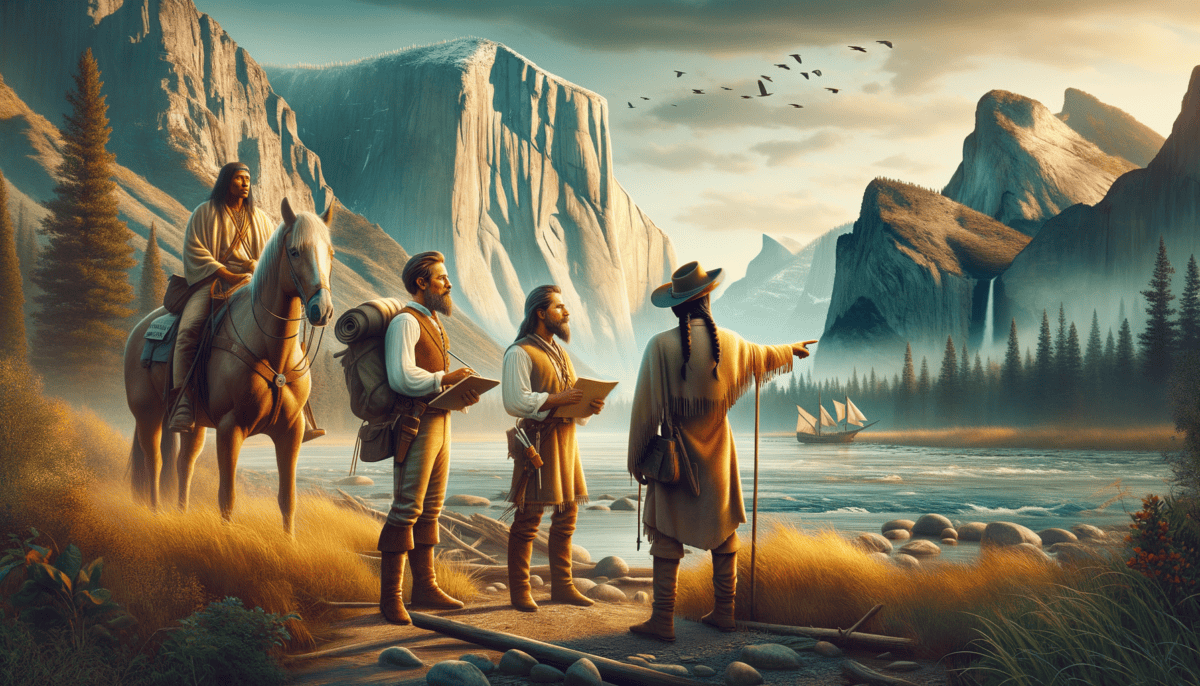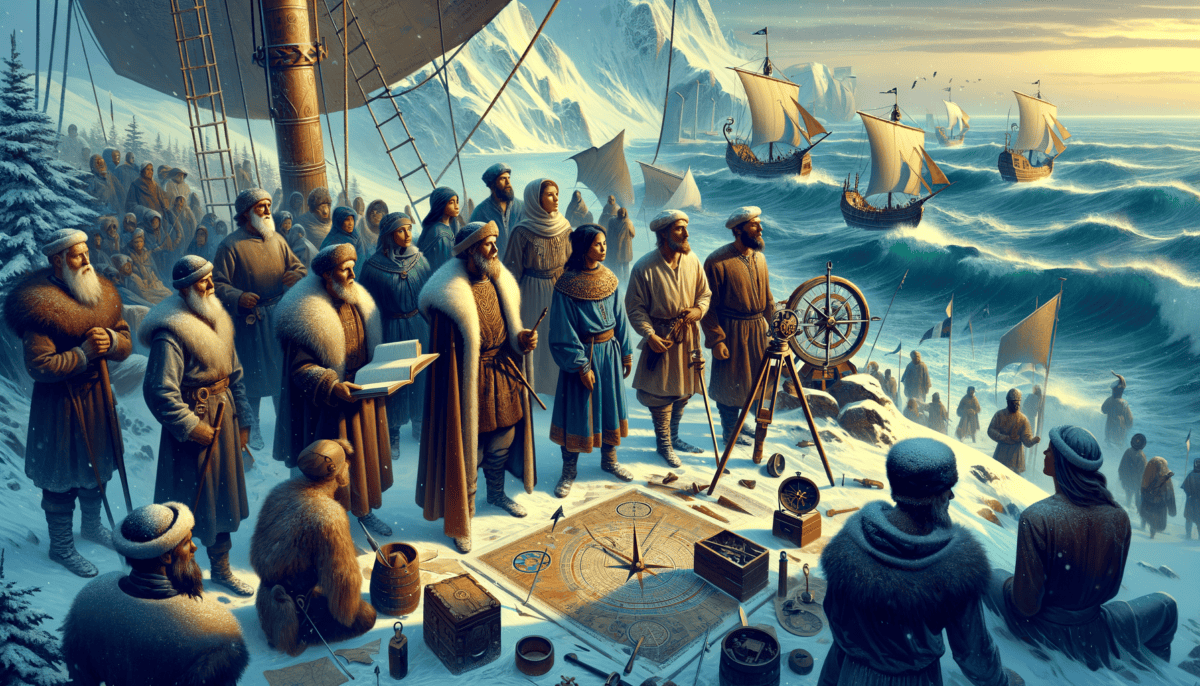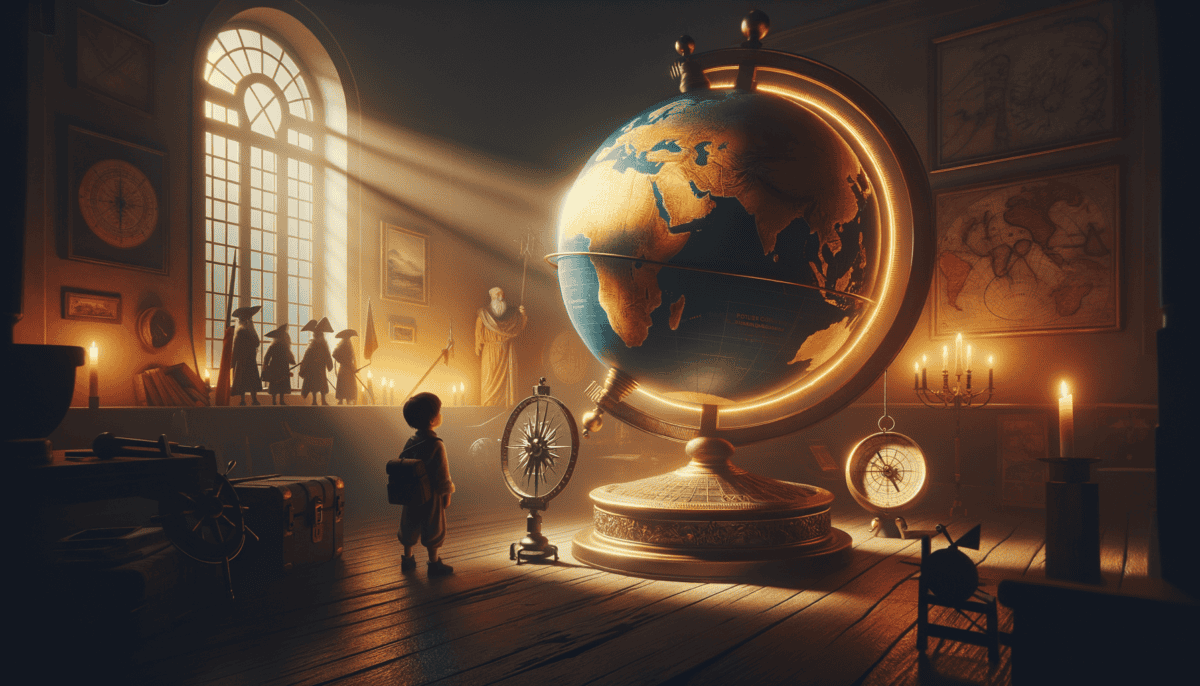A Viking’s Heart
The cold wind whipped across Leif Eriksson's face as he stood at the bow of his mighty longship. The salty spray made his red beard glisten in the morning sun. At just 25 years old, Leif was about to lead his crew into the unknown western seas.
"Father, are you sure about these tales of lands beyond Greenland?" young Erik asked, tugging at Leif's thick wool cloak.
Leif smiled at his son. "Sometimes we must trust our hearts and be brave, even when we're not sure what lies ahead."
The wooden dock creaked beneath their feet as the crew loaded the last supplies. Their longship was a marvel of Viking craftsmanship, with a fearsome dragon head carved into the front. The ship's tall mast held a square wool sail that would catch the wind and carry them west.
"Check the supplies again!" Leif called out to his crew. They needed enough food and fresh water for many weeks at sea. The sailors packed:
• Dried fish and meat
• Barrels of fresh water
• Hard bread
• Warm furs and blankets
• Tools for repairs
• Weapons for protection
Erik watched in wonder as the sailors worked. "How will you know which way to go?" he asked his father.
"We have many tricks," Leif explained. "We watch the stars at night. During the day, we follow the sun. We also have this." He pulled out a small sundial compass, its surface gleaming.
The morning sun climbed higher as final preparations were made. Families gathered on the dock to say goodbye. Mothers hugged their sons. Children waved to their fathers. Even the bravest Vikings felt butterflies in their stomachs before such a dangerous journey.
The success of their mission depended on working together as one crew. Each person had an important job to do.
"All aboard!" Leif's voice boomed across the harbor. The crew scrambled onto the ship, taking their places at the oars. Leif gave his son one last hug.
"Be brave while I'm gone," he whispered. "Help your mother. I'll bring back amazing stories of new lands."
As the longship pulled away from the dock, Erik ran along the shore, waving until the ship disappeared into the misty horizon. The great adventure had begun!
The first few days were rough. Giant waves crashed over the ship's sides. The wind howled like an angry wolf. But the Vikings were strong sailors who had faced worse storms.
"Keep rowing!" Leif encouraged his men. "The gods test our courage!"
After a week at sea, they spotted something exciting – chunks of ice floating in the water. This meant they were getting close to new lands! The crew cheered and rowed harder.
“The world is vast and full of wonders,” Leif told his crew. “We Vikings are brave enough to find them!”
Soon, a dark line appeared on the horizon. As they got closer, they could see it was land – a place no Viking had ever mapped before! Tall trees covered rocky cliffs that rose from the sea.
"Drop anchor!" Leif commanded. "Prepare to explore!"
The men readied their weapons and supplies, eyes wide with excitement. What mysteries would they find on these strange shores? What tales would they bring home to their families? Their great journey of discovery was just beginning…
Dreams Across the Ocean
The sun blazed hot over the Spanish harbor as Christopher Columbus checked his maps one last time. Three ships bobbed gently in the water – the Niña, Pinta, and Santa Maria. They would soon carry him and his crew across the vast ocean.
“Captain, the last supplies are loaded,” called Juan, his young cabin boy. “But some sailors are scared. They say we’ll fall off the edge of the world!”
Columbus smiled kindly. “The world is round like an orange, Juan. We won’t fall off – we’ll find a new way to reach India.”
The docks buzzed with activity as families said goodbye. Queen Isabella had given Columbus three ships and crews after years of begging for help. Now he had to prove he could find a westward route to Asia.
Juan watched the sailors store the last items they would need:
• Food for many months
• Fresh water in big barrels
• Maps and navigation tools
• Medicine for sick sailors
• Seeds to plant in new lands
• Gifts for people they might meet
“Time to board!” Columbus called out. His voice shook a little – even brave captains get nervous before big adventures.
The wooden ships creaked as sailors climbed aboard. Some made the sign of the cross and whispered prayers. Nobody had ever sailed so far west before. What if there really were sea monsters?
“We sail for glory and gold!” Columbus announced. “God and Queen Isabella are watching over us!”
As they left the harbor, Columbus wrote in his diary: “Today we begin our great journey. May fortune favor the brave.”
Days turned into weeks. The wind pushed them west, but fear grew among the crew. Food started to spoil. Fresh water turned green. Some men got sick.
“Look! Strange birds!” Juan shouted one morning. “And green plants floating in the water!”
Columbus smiled. These were signs of land nearby. But day after day, they saw only endless waves.
“Three more days,” he promised his angry crew. “Give me three more days to find land.”
On October 11, 1492, everything changed. Juan spotted something in the moonlight.
“Captain! Captain! A light on the horizon!”
The crew rushed to the rail. Was it really land? Or just another false hope?
As the sun rose the next morning, tears filled Columbus’s eyes. There it was – a beautiful green island with white sandy beaches. Birds flew overhead. Palm trees swayed in the breeze. ️
“Land ho!” the lookout shouted. The crew cheered and hugged each other. After 71 days at sea, they had found something amazing!
Juan tugged at Columbus’s sleeve. “What will we find here, Captain?”
“A new world of wonders, my boy. A new world of wonders…”
As they dropped anchor, Columbus didn’t know he had found a place no European had seen before. He thought he had reached Asia. Instead, he had opened the door to a whole new chapter in human history.
Around the World We Go
Ferdinand Magellan stood on the docks of Spain, looking at his five ships with pride. The year was 1519, and he had a big dream – to sail all the way around the world!
“Captain, the ships are ready,” said Francisco, his trusted helper. “But the men are asking – has anyone ever gone all the way around before?”
“No one has done it yet,” Magellan said with a smile. “We will be the first!”
The smell of salt water filled the air as sailors loaded the last supplies. King Charles of Spain had given them everything they needed for a long journey:
• Food for two years
• Maps and special tools
• Warm clothes for cold weather
• Medicine and bandages
• Trade goods for new friends
• Strong ropes and extra sails
“Listen well!” Magellan called to his crew. “We will sail west, find a path through the Americas, and reach the Spice Islands!”
“But Captain,” a sailor asked, “what about the stories of giant whales and storms that can sink ships?”
Magellan’s voice was strong and sure. “We are brave explorers! Together, we can face any challenge!”
The journey started well, but soon they faced big problems. The food got moldy. Rats ate their supplies. Many sailors got sick. Some wanted to go home.
Then came the really hard part – finding a way through South America. The ships searched for weeks along the coast.
“Look!” Francisco shouted one cold morning. “A gap between the mountains!”
They had found what we now call the Strait of Magellan. But it was dangerous! Strong winds pushed against them. Sharp rocks hid under the water. One ship crashed and sank. Another turned back to Spain.
After 38 days of careful sailing, they made it through! The water ahead looked calm and peaceful.
“We’ll call this the Pacific Ocean,” Magellan said. “Pacific means peaceful.”
But the Pacific Ocean was huge! Much bigger than anyone knew. For three months, they saw no land. Food ran out. Sailors ate leather from old shoes to survive.
“We must keep going,” Magellan wrote in his journal. “Our dreams are bigger than our fears.”
Finally, they reached islands with fresh food and friendly people. But during a fight on one island, Magellan died. His crew was very sad, but they knew they had to finish the journey.
“The captain would want us to keep going,” Francisco told everyone.
Only one ship, the Victoria, made it back to Spain. Just 18 sailors survived. But they had done something amazing – the first trip all the way around the world!
That night, Francisco looked at the stars and smiled. “We did it, Captain,” he whispered. “We showed everyone that the world is round, and all its oceans are connected.”
The great journey had taken three years, but it changed how people saw the world forever. Maps had to be redrawn. The oceans seemed a little less scary. And everyone knew that brave explorers could do incredible things if they worked together.
Into the Wild West
In 1804, two brave explorers named Meriwether Lewis and William Clark stood at the edge of the Mississippi River. President Thomas Jefferson had given them a big job – to find a way across America to the Pacific Ocean! ️
“Look at all that unknown land ahead,” Lewis said to Clark, pointing west. “No American has ever mapped it before.”
Clark smiled and adjusted his pack. “Then we’ll be the first! But we can’t do it alone.”
They packed their boats with important things:
• Medicine and bandages
• Warm clothes and blankets
• Tools for making maps
• Gifts for Native Americans
• Food and cooking pots
• Guns for hunting
“What’s that?” asked one of the men, pointing at some strange instruments.
“Those are special tools,” Lewis explained. “We’ll use them to study plants and animals no one has ever seen before!”
As they traveled up the Missouri River, they met many Native American tribes. A young Native American woman named Sacagawea joined them as a guide.
“Without Sacagawea, we’d be lost,” Clark wrote in his journal. She knew which plants were safe to eat and how to speak to different tribes.
“Look!” Sacagawea called one day. “Buffalo! More than anyone can count!”
The team saw amazing things every day. They found huge bears with silver fur (grizzly bears). They saw waterfalls taller than buildings. They drew pictures of new flowers and collected seeds to take home.
But it wasn’t easy! The weather turned cold. Food was hard to find. Mountains seemed to stretch forever.
“The mountains ahead look like they touch the clouds,” wrote Lewis. “But we must find a way through.”
One morning, a young explorer named George ran back to camp excited. “Captain Lewis! Captain Clark! I found something!”
He led them to a small stream. “This water is flowing west,” Clark said with a big smile. “It will lead us to the Pacific!”
They built canoes and followed the water. Days later, they heard a loud roar.
“The ocean!” shouted Sacagawea. “We made it!”
The team had traveled over 8,000 miles! They had crossed mountains, forests, and prairies. They had made friends with many Native American tribes and drawn maps of the whole journey.
That night, they sat around the fire near the Pacific Ocean. “Just think,” said Clark, “now others can follow our path.”
Lewis nodded. “And they’ll know about all the wonderful people, animals, and places we found.”
The explorers had shown that it was possible to cross America by land. Their maps and notes would help many others follow their trail. But most importantly, they showed that when people work together and help each other, they can do amazing things! ⭐
The Price of Discovery
The sun beat down on an ancient Maya temple as a group of Spanish explorers wiped sweat from their faces. “These buildings are amazing!” said young Miguel, touching the warm stone walls. “But where are all the people who built them?” ️
His question hung heavy in the air. Many explorers had asked similar things around the world.
“My grandfather told me about when the first ships came,” said Running Deer, a Native American boy speaking to his friend. “Our whole way of life changed after that.”
In Africa, a village elder named Jabari sat with his grandchildren. “The explorers brought new tools and ideas,” he said. “But they also took many things from our land.”
“Sometimes being brave means knowing when to be careful,” wrote Captain James Cook in his diary. “We must remember that every new land we find is already someone’s home.” ⭐
But exploration also brought good things. People learned new ways to:
• Grow different foods
• Build better boats
• Make maps
• Learn new languages
• Share stories
• Find cures for sickness
Maria stood at the helm of her research ship. Unlike the old explorers, she had special tools to help her:
“We have GPS to guide us,” she said. “And we can talk to people anywhere in the world. But we still need to be careful about how we explore.”
In the Amazon rainforest, Dr. Chen worked with local tribes to learn about plants that could help sick people. “We work together now,” she explained. “The local people teach us, and we learn from each other.”
Far away in the Arctic, Anik and his team used new technology to study melting ice. “The old explorers helped us make maps,” he said. “Now we use those maps to protect these places.”
Back at the Maya temple, Miguel looked at his compass. Next to him, Maya children played with his digital camera.
“Want to see something cool?” asked Luna, a Maya girl. She showed Miguel how her people could read the stars without any tools.
“That’s amazing!” Miguel said. “Maybe we could work together and learn from each other?”
“The best explorers are the ones who listen and learn,” Luna’s grandmother said with a smile. “Not just the ones who want to find new things.”
Dr. Sarah Jones sat in her modern lab, looking at old explorer journals. “These early explorers were brave,” she said. “But today we know that the bravest thing is to explore while protecting people and nature.”
She pointed to a group of young scientists from different countries working together. “Look at them – sharing ideas, respecting each other. That’s what exploration should be about.”
The world had changed a lot since the first explorers set sail. Now people knew that finding new places was just the start. The real adventure was learning how to explore in ways that helped everyone!
Pathways to Tomorrow
The morning sun sparkled on the International Space Station as astronaut Maya Rodriguez looked down at Earth. “When I was little, I read about explorers like Columbus and Magellan,” she said. “Now I’m exploring space!”
Deep in the ocean, Dr. James Chen guided a small submarine through dark waters. “Every day we find amazing new sea creatures,” he said into his radio. “The ocean is like a whole new world!”
“Look what the robot found!” shouted Sarah, a young scientist in Antarctica. On her computer screen, a tiny camera showed ice that was millions of years old. “This ice tells us stories about Earth’s past!”
“The spirit of exploration lives in all of us,” wrote Maya in her space diary. “We just explore in different ways now.” ⭐
Around the world, new kinds of explorers were making discoveries:
• Ocean scientists finding new sea animals
• Cave explorers mapping underground rivers
• Space teams looking for new planets
• Forest rangers protecting wild animals
• Robot builders making machines to explore volcanoes
• Young students learning about nature
In the Amazon rainforest, Maria worked with local children to plant trees. “We’re exploring ways to help the Earth,” she said, wiping sweat from her forehead. “That’s just as important as finding new places.”
“The best explorers today work together,” said Dr. Lee at his laboratory. “We share what we learn with everyone around the world.”
Young Tommy sat in his wheelchair, using special glasses to explore virtual mountains. “I can go anywhere!” he laughed, reaching out to touch a virtual butterfly. “Technology helps everyone be an explorer!”
In Africa, Amara used her phone to take pictures of rare animals. “My great-grandmother used to tell stories about explorers coming to our village,” she said. “Now we’re the ones exploring and protecting our land.”
“Every child is born an explorer,” said Teacher Jones to her class. “You just need to be curious and kind.”
Back on the Space Station, Maya watched the Earth spin below. She thought about all the explorers who had come before her – the Vikings crossing stormy seas, Columbus sailing west, Magellan circling the globe, and Lewis and Clark mapping new lands.
“They would be amazed to see us now,” she said, touching the window. “But they would understand our excitement. The wish to explore is still the same!”
In schools around the world, children learned about both old and new explorers. They understood that exploring wasn’t just about finding new places – it was about learning, sharing, and caring for our world.
“What will you explore?” asked Maya during a video call with students. A hundred hands shot up, each child bursting with ideas.
“I want to save the rainforest!”
“I’m going to explore Mars!”
“I want to help clean the oceans!”
Maya smiled. The spirit of exploration that had pushed the Vikings across the sea, guided Columbus to new shores, and led Magellan around the world was still alive. It lived in labs and classrooms, in forests and oceans, and in the hearts of children everywhere.
The future was waiting, full of new mysteries to solve and wonders to discover. And this time, everyone could be part of the adventure!


